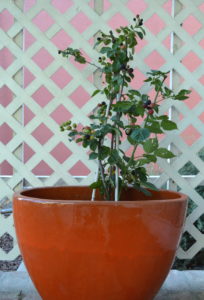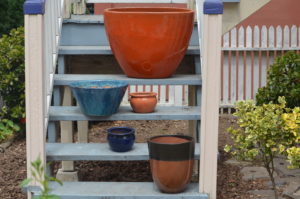Growing Fruit in Containers
Container growing is an excellent option for more than just flowers and herbs. You can grow a variety of delicious fruits in containers by choosing the right varieties and providing the right conditions. You may already be growing dwarf fruit trees in containers, now consider expanding your home-grown fruit basket to include container-grown strawberries, raspberries, blueberries, or even grapes.
Strawberries have long been popular as container plants. Multi-pocketed “strawberry jars” were developed long ago so that many strawberry plants could be grown around the sides and out the top of a terra cotta pot. Any variety of strawberry can be grown in a container and they do particularly well in hanging baskets or stacked pots so that the plants can spill over the edges, keeping the fruit from laying on the soil.
Recently developed varieties of raspberries and blueberries, such as ‘Raspberry Shortcake’ and ‘Blueberry Glaze’, have been bred for a more compact growth habit suitable for containers and perfect for decorating a patio. While raspberries can be grown singly, blueberries need cross-pollination from a second plant, so plan on planting more than one container of blueberries.
 Thornless blackberries are another delicious option for container-growing. Most thornless varieties, such as ‘Arapaho’, ‘Chester’, and ‘Triple Crown’, are less vigorous growers than the thorned varieties but still produce a good amount of berries. Even in containers blackberry canes will grow long enough to require staking, so plan on installing a trellis or cage when you plant.
Thornless blackberries are another delicious option for container-growing. Most thornless varieties, such as ‘Arapaho’, ‘Chester’, and ‘Triple Crown’, are less vigorous growers than the thorned varieties but still produce a good amount of berries. Even in containers blackberry canes will grow long enough to require staking, so plan on installing a trellis or cage when you plant.
Grapes are another option for container growing. You can stake a grape vine and train it into a “weeping” form with the branches cascading downward, or you can attach a trellis to support the branches growing horizontally. There are even newly cultivated dwarf grape vines called Pixie®grapes that grow to just 18–24” and can be grown in a table-top container.
Be sure to select a plant that is suited to container growing, meaning that it is bred for or capable of being trained into a compact form. With the right plant selection and the right growing conditions—full sun, regular water, and feeding—your morning fruit bowl can be picked right from your patio!
Materials List:
 Fruiting plant
Fruiting plant- Container
- Potting mix
- Perlite
- Trellis or stake (for grapes only)
- Mulch
- Compost
Steps:
- Select the Right Plant: Select a plant with a compact form suitable for container growing, such as the varietals listed above. For raspberries, blueberries, and grapes, check that the number of chill hours* required is appropriate for your region.
- Pick the Right Size Container: Strawberries can be grown singly in small (4–6”) pots or grouped together in larger pots. Raspberries and blueberries do best in containers larger than 5 gallons. Grapes require 10- to 15-gallon containers. Make sure the container has holes for drainage.
- Choose the Right Location: Position the container in a spot with at least 6 hours of direct sunlight each day and minimal wind.

- Pot It Up: To provide better drainage, mix about three parts potting soil to one part perlite. Fill the container about two-thirds of the way with the soil/perlite mixture. Remove the plant from the nursery pot and place it on top of the soil. Fill in the rest of the container with more soil, adjusting the position of the plant to ensure that the plant is buried only as deeply as it was in the nursery pot–don’t pile soil up around the stem of the plant. Add water to make sure the soil settles and that there are no air pockets around the root ball. Add more soil if needed.
- Stake It: For grapes, insert a stake or other support structure and loosely tie the trunk to it.
- Add Mulch: Apply 3 inches of mulch on top of the soil to minimize evaporation and suppress weeds, but be sure to keep the mulch away from the stem or canes to prevent rot.
- Water Regularly: Keep the plant evenly moist and make sure it doesn’t dry out during heat waves. Setting up drip irrigation will make this easier.
- Feed Monthly: Apply a side-dressing of compost throughout the growing season. Fertilizing more than this can produce lush vegetation, but not necessarily more fruit.
*Chill hours refers to the number of hours when the air temperature is below 45°F. Some plants require a minimum amount of chill in order to set fruit. Check this chart from the UC Davis Fruit & Nut Research & Information Center to find the number of chill hours recorded in your area and select a plant that requires no more than that amount of chill.
